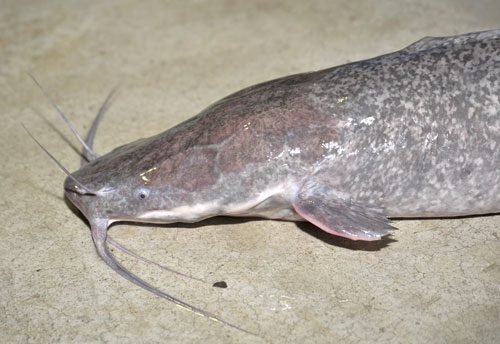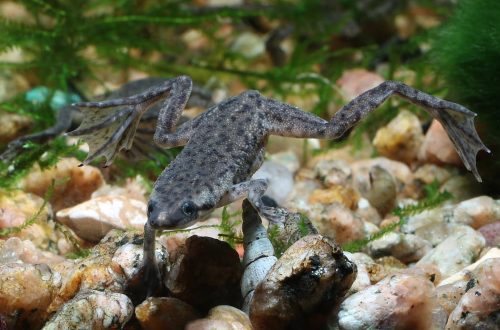
Exterior, keeping and breeding in captivity of catfish Clarius Angolan and spotted
The difference between Clarius catfish is a long dorsal fin, stretching from the back of the head to the very tail, it also has a long tail fin and eight antennae. Two of them are in the area of the nostrils, 2 on the lower jaw and 4 are under the jaw. The body of catfish Clarius is spindle-shaped (eel-shaped). There are tree-like accessory organs on the gill arches. There are no scales or small bones. Inhabits Clarias catfish waters of Southwest and Southeast Asia and Africa.
Contents
See Claries Gariepina
- African catfish Clariy.
- Catfish marble Clariy.
- Clarias Nile.
The body shape of Clarius is similar to an eel and a gray catfish. The color of the skin depends on the color of the water, as a rule, marble, has a gray-greenish tint. Clarius becomes sexually mature at the age of about one and a half years, at this time Clarius weighs up to 500 grams and has a length of up to 40 centimeters. Representatives of the Clarias species grow up to 170 centimeters, reaching a weight of 60 kilograms. The life span is about 8 years.
From the gill cavities of Clarius catfish outgrowth organ in the form of a tree branch. Its walls are permeated with blood vessels having a very large total surface. In other words, it is an organ that allows him to breathe while on land. The najaber organ is filled with air and is effective when the air has a humidity of about 80%. If gill breathing is completely excluded, this can cause the death of the animal. Clarius is allowed to be transported without water at a sufficient temperature to prevent hypothermia. Temperatures below 14 degrees lead to Clarias catfish death.
The catfish Clarius has an organ capable of generating electricity. During spawning, Clarius individuals communicate through electrical discharges. They also generate electrical discharges when an alien of the same species appears with them, which is included in the signaling system of fish of this species. The stranger can get away or accept the call and, in turn, issue similar signals.
Catfish of the Clarius species are comfortable when the amount of oxygen dissolved in water is at least 4,5 mg / liter and access to the surface of the water is free. When living conditions change, he crawls into another lake.
Pretty omnivorous, can eat:
- shellfish;
- fish;
- water beetles;
- vegetable food.
- and does not shy away from garbage.
It is an object of fishing and fish farming.
Spotted Clarius (Clarius batrachus)
Otherwise it is called frog clariid catfish. In captivity it grows up to 50 cm, in nature it reaches 100 cm. An inhabitant of the lakes of Southeast Asia. Clarius spotted is a fairly inexpensive food item in Thailand.
There are several varieties of Clarius spotted catfish with varying coloration ranging from greyish brown to grey. Also olive with a gray belly. In the aquarium, the albino Form of Clarius spotted is popular – white with red eyes.
Sex differences: male catfish Clarius spotted are more brightly colored, adults have gray spots at the end of the dorsal fin. Albinos have a different shape of the abdomen – it is more rounded in females.
Able to breathe air. To do this, Clarias spotted allows you to make the supra-gill organ. But in an aquarium, this need arises only after a hearty dinner, then it rises to the surface of the water. In nature, this organ allows it to migrate from one body of water to another.
The appearance of Clarias catfish resembles a sac-gill catfish, but Clarius catfish is much more active and bolder. The next difference between them is the dorsal fin. Short in the sackgill catfish, in Clarius it is long, stretching along the entire back. The dorsal fin has 62-67 rays, the anal fin has 45-63 rays. These fins do not reach the caudal fin, interrupting in front of it. Four pairs of whiskers are located on the muzzle, their sensitivity allows the fish to find food. The eyes are small, but studies have shown that they have cones similar to those in the human eye. And this allows the fish to distinguish colors. This is an amazing fact, given that he lives in the gloomy bottom layers.
You can keep catfish Clarius spotted both in pairs and singly. However, they must be taken into account aggressiveness and greediness. Clarius devours even large fish living with him. Together with him, you can keep large Cichlids, pacu, Arovans, large catfish, but not the fact that he will not eat them.
Adult Clarius should be kept in an aquarium of at least 300 liters with a tight-fitting lid, otherwise the catfish will certainly want to explore the apartment. Catfish can stay out of water for about 30 hours. Putting the Clarias catfish back, you should be careful – on the body of this catfish there are poisonous spikes, contact with which leads to painful tumors.
Large and voracious predator. In nature, it feeds on:
- shellfish;
- small fish;
- aquatic weeds and detritus.
Therefore, in the aquarium they feed him with small livebearers, worms, granules, pieces of fish. Do not give the meat of animals and birds. Clarius catfish does not digest it well, which leads to obesity.
Puberty is coming with a size of 25-30 centimeters, that is, by the age of about one and a half years. Rarely propagated in an aquarium, since reproduction requires large containers. You need to put a flock of catfish in the aquarium and they themselves will be divided into pairs, after which the pairs must be planted, as they become very aggressive.
Reproduction
Spawning of Clarius catfish begins with mating games. Fish in pairs swim around the aquarium. Under natural conditions, Clarius dig a hole in the sandy shores. In the aquarium, they prepare a spawning site by digging a hole in the ground, where they then lay several thousand eggs. The male guards the clutch for about a day, and when the eggs hatch, the female. As soon as the larvae hatched, parents need put away to avoid cannibalism. Malek grows up quite quickly, since that time showing the inclinations of an ardent predator. For food they need a pipe maker, a small bloodworm, Artemia naupilias. Due to the tendency to gluttony, they need to be fed in small portions several times during the day.
Angolan Clarius (Clarius angolensis)
Another name is Sharmut or Karamut. In nature, it is found in the brackish and fresh waters of central and western Africa. It is similar to the Indian sackgill flathead catfish. In nature, the Angolan Clarius catfish grows up to 60 centimeters, less in an aquarium.
Exterior
On the head near the mouth are four pairs of whiskers, constantly moving in search of food. The shape of the head of the Angolan Clarius catfish is flattened, large. The eyes are small. A long dorsal fin begins behind the head. The anal fin of the Angolan Clarias is shorter than the dorsal, and the caudal fin is rounded. The pectoral fins have sharp spines. Angolan Clarius color bluish to black, belly white.
Aquarium from 150 liters and more. Plants with a developed root system should be planted in pots.
Angolan Clarius is very aggressive, devouring everyone who is noticeably smaller than him.
Diet catfish Clarius Angolan matches the inclinations:
- Bloodworm;
- Trumpet;
- Granular feed;
- Pieces of squid;
- Pieces of lean fish;
- Sliced beef heart.





